
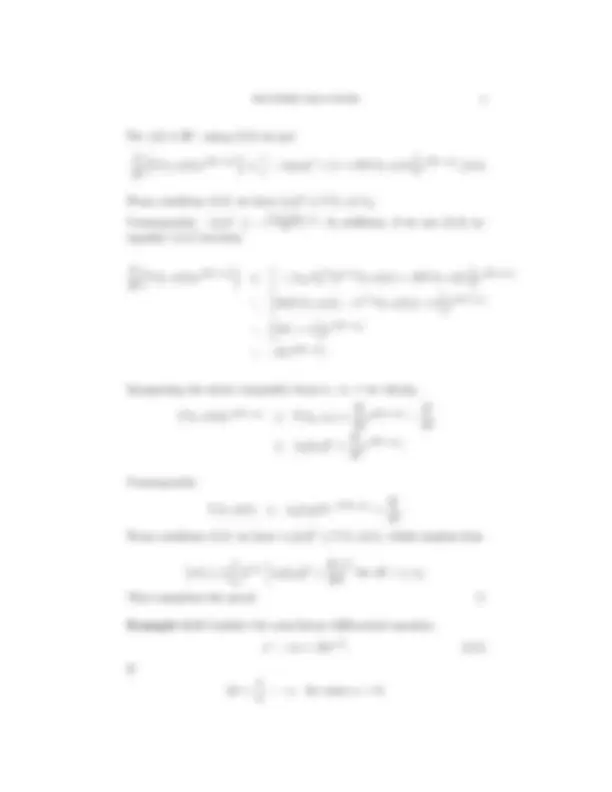
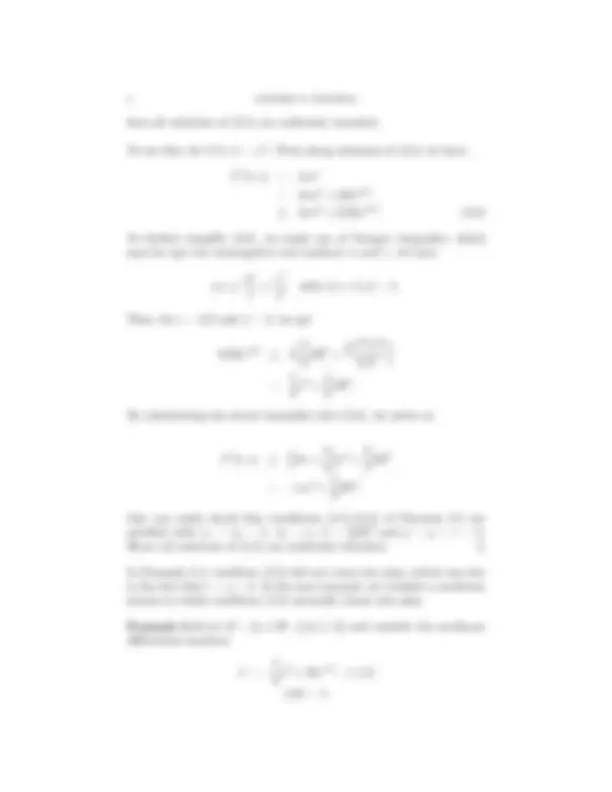
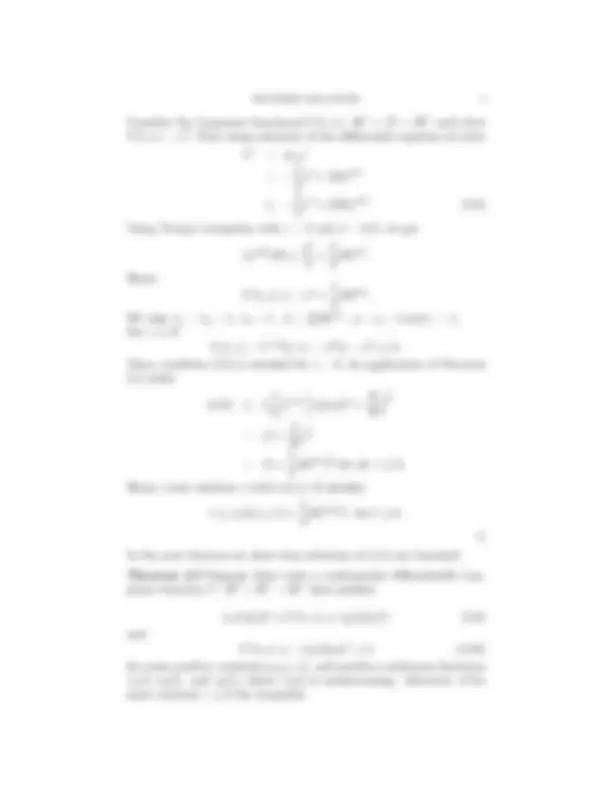
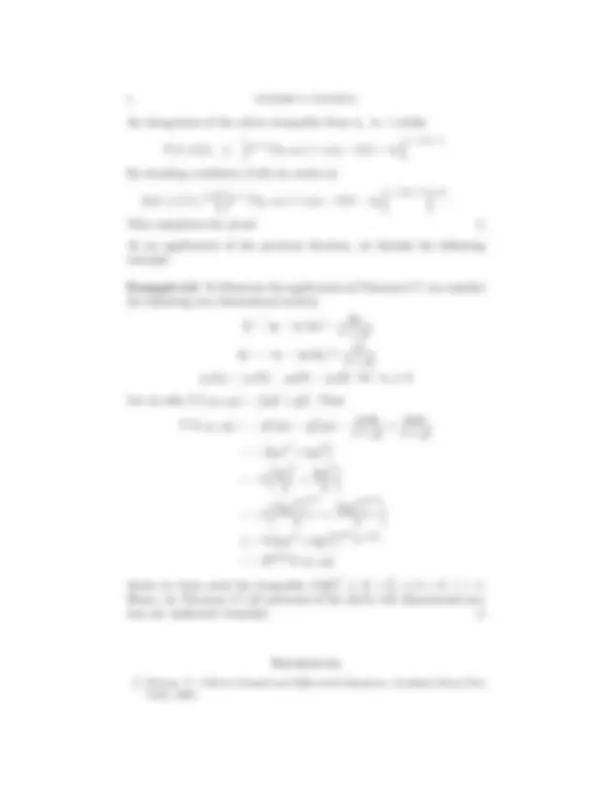
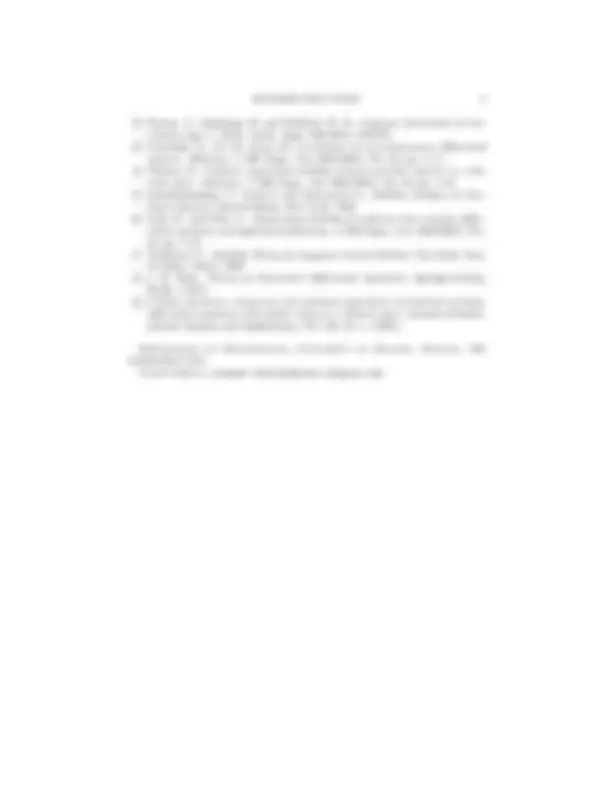


Study with the several resources on Docsity

Earn points by helping other students or get them with a premium plan


Prepare for your exams
Study with the several resources on Docsity

Earn points to download
Earn points by helping other students or get them with a premium plan
Community
Ask the community for help and clear up your study doubts
Discover the best universities in your country according to Docsity users
Free resources
Download our free guides on studying techniques, anxiety management strategies, and thesis advice from Docsity tutors
The boundedness of solutions in nonlinear differential equations using Lyapunov functions. The author employs non-negative definite Lyapunov functions to obtain sufficient conditions for the boundedness of all solutions of a given nonlinear differential system. The document also includes examples and references.
What you will learn
Typology: Lecture notes
1 / 9

This page cannot be seen from the preview
Don't miss anything!






YOUSSEF N. RAFFOUL
Abstract. Non-negative definite Lyapunov functions are employed to obtain sufficient conditions that guarantee boundedness of so- lutions of a nonlinear differential system. The theory is illustrated with several examples.
In this paper, we make use of non-negative definite Lyapunov functions and obtain sufficient conditions that guarantee the boundedness of all solutions of the initial value problem
x˙ = f (t, x), t ≥ 0 , x(t 0 ) = x 0 , t 0 ≥ 0
where x ∈ Rn, f : R+^ × Rn^ → Rn^ is a given nonlinear continuous function in t and x, where t ∈ R+. Here Rn^ is the n-dimensional Euclidean vector space; R+^ is the set of all non-negative real numbers; ‖x‖ is the Euclidean norm of a vector x ∈ Rn. Our interest in studying the boundedness of solutions of (1.1) arises from the fact that in the study of the stability of the zero solution of (1.1) when f (t, 0) = 0, one may have to assume the existence of solutions for all positive time. For more on the stability, we refer the interested reader to [1] and [6]. In [2], the authors obtained , using positive definite Lyapunov functionals, interesting results regarding the boundedness of solutions of systems that are similar to (1.1). For more results regarding the stability of the zero solution or boundedness of solutions of (1.1), we refer the interested reader to [4], [5], [7] and [9]. In the spirit of the work in [3] and [6], in this investigation, we establish sufficient conditions that yield all solutions of (1.1) are bounded. We achieve this by assuming the existence of a Lyapunov function that is bounded below and above and that its derivative along the trajectories of (1.1) to be bounded by a negative definite function, plus a positive constant.
1991 Mathematics Subject Classification. 34C11, 34C35, 34K15. Key words and phrases. Nonlinear differential system, Boundedness; Lyapunov functions. 1
2 YOUSSEF N. RAFFOUL
In this section we use non-negative Lyapunov type functions and estab- lish sufficient conditions to obtain boundedness results on all solutions x(t) of (1.1). From this point forward, if a function is written without its argument, then the argument is assumed to be t.
Definition 2.1 We say that solutions of system (1.1) are bounded, if any solution x(t, t 0 , x 0 ) of (1.1) satisfies
||x(t, t 0 , x 0 )|| ≤ C
||x 0 ||, t 0
, for all t ≥ t 0 ,
where C : R+^ × R+^ → R+^ is a constant that depends on t 0 and x 0. We say that solutions of system (1.1) are uniformly bounded if C is independent of t 0.
If x(t) is any solution of system (1.1), then for a continuously differen- tiable function
V : R+^ × Rn^ → R+,
we define the derivative V ′^ of V by
V ′(t, x) =
∂V (t, x) ∂t
∑^ n
i=
∂V (t, x) ∂xi
fi(t, x).
Theorem 2.2 Let D be a set in Rn. Suppose there exist a continuously differentiable Lyapunov function V : R+^ × D → R+^ that satisfies
λ 1 ||x||p^ ≤ V (t, x) ≤ λ 2 ||x||q, (2.1)
and
V ′(t, x) ≤ −λ 3 ||x||r^ + L (2.2)
for some positive constants λ 1 , λ 2 , λ 3 , p, q, r and L. Moreover, if for some constant γ ≥ 0 the inequality
V (t, x) − V r/q(t, x) ≤ γ (2.3)
holds, then all solutions of (1.1) that stay in D are uniformly bounded.
Proof Let M = λ 3 /λr/q 2. For any initial time t 0 , let x(t) be any solution of (1.1) with x(t 0 ) = x 0. Then,
d dt
V (t, x(t))eM^ (t−t^0 )
V ′(t, x(t)) + M V (t, x(t))
eM^ (t−t^0 ).
4 YOUSSEF N. RAFFOUL
then all solutions of (2.5) are uniformly bounded.
To see this, let V (t, x) = x^2. Then along solutions of (2.5) we have
V ′(t, x) = 2 xx′ = 2 σx^2 + 2Rx^4 /^3 ≤ 2 σx^2 + 2|R|x^4 /^3. (2.6)
To further simplify (2.6), we make use of Young’s inequality, which says for any two nonnegative real numbers w and z, we have
wz ≤
we e
zf f
, with 1/e + 1/f = 1.
Thus, for e = 3/2 and f = 3, we get
2 |R|x^4 /^3 ≤ 2
(x^4 /^3 )^3 /^2 3 / 2
x^2 +
By substituting the above inequality into (2.6), we arrive at
V ′(t, x) ≤
2 σ +
x^2 +
= −αx^2 +
One can easily check that conditions (2.1)-(2.3) of Theorem 2.2 are satisfied with λ 1 = λ 2 = 1, λ 3 = α, L = 23 |R|^3 and p = q = r = 2. Hence all solutions of (2.5) are uniformly bounded. ♦
In Example 2.3, condition (2.3) did not come into play, which was due to the fact that r = q = 2. In the next example, we consider a nonlinear system in which condition (2.3) naturally comes into play.
Example 2.4 Let D = {x ∈ R : ||x|| ≥ 1 } and consider the nonlinear differential equation
x′^ = −
x^3 + Rx^1 /^3 , t ≥ 0 , x(0) = 1.
BOUNDED SOLUTIONS 5
Consider the Lyapunov functional V (t, x) : R+^ × D → R+^ such that V (t, x) = x^2. Then along solutions of the differential equation we have
V ′^ = 2 xx′ = −
x^4 + 2Rx^4 /^3
≤ −
x^4 + 2|R|x^4 /^3 (2.8)
Using Young’s inequality with e = 3 and f = 3/2, we get
|x|^4 /^3 |R| ≤
x^4 3
Hence
V ′(t, x) ≤ −x^4 +
We take λ 1 = λ 2 = 1, λ 3 = 1 , L = 43 |R|^3 /^2 , p = q = 2 and r = 4. For x ∈ D V (t, x) − V r/q(t, x) = x^2 (1 − x^2 ) ≤ 0.
Thus, condition (2.3) is satisfied for γ = 0. An application of Theorem 2.2 yields
|x(t)| ≤ {
λ 1
}^1 /p
λ 2 ||x 0 ||q^ +
] (^1) p
(^12)
1 (^2) for all t ≥ 0.
Hence, every solution x with x(t) ∈ D satisfies
1 ≤ |x(t)| ≤ (1 +
1 (^2) , for t ≥ 0.
♦
In the next theorem we show that solutions of (1.1) are bounded.
Theorem 2.5 Suppose there exist a continuously differentiable Lya- punov function V : R+^ × Rn^ → R+^ that satisfies
λ 1 (t)||x||p^ ≤ V (t, x) ≤ λ 2 (t)||x||q, (2.9)
and V ′(t, x) ≤ −λ 3 (t)||x||r^ + L (2.10)
for some positive constants p, q, r, L, and positive continuous functions λ 1 (t), λ 2 (t), and λ 3 (t), where λ 1 (t) is nondecreasing. Moreover, if for some constant γ ≥ 0 the inequality
BOUNDED SOLUTIONS 7
d dt
V (t, x)eλ^2 t
≤ Leλ^2 t
An integration of the above inequality from t 0 to t yields
V (t, x) ≤ V (t 0 , x 0 )e−λ^2 (t−t^0 )^ +
λ 2
Using (2.14) into the above inequality, we have
||x|| ≤ {
λ 1
}^1 /p
V (t 0 , x 0 ) +
λ 2
] (^1) p for all t ≥ t 0.
This completes the proof. ♦
In the next theorem our Lyapunov function satisfies a different type of condition on its derivative along the solutions. Theorem 2.7 Suppose there exist a continuously differentiable Lya-
punov function V : R+^ × Rn^ → R+^ that satisfies
λ 1 ||x||p^ ≤ V (t, x), V (t, x) 6 = 0 if x 6 = 0 (2.16)
and V ′(t, x) ≤ −λ 2 (t)V q(t, x) (2.17)
for some positive constants λ 1 , p, q > 1 where λ 2 (t) is a positive con- tinuous function such that
c 1 = inf t≥t 0 ≥ 0 λ 2 (t) > 0. (2.18)
Then all solutions of (1.1) are bounded.
Proof For any initial time t 0 ≥ 0, let x(t) be any solution of (1.1) with x(t 0 ) = x 0. By calculating
d dt
V (t, x(t))
along the solutions of (1.1) and making use of (2.17) and (2.18), we obtain
V ′(t, x(t)) ≤ −λ 2 (t)V q(t, x(t)) ≤ −c 1 V q(t, x(t)).
Denoting u(t) = V (t, x(t)), we have that this function satisfies the following differential inequality
u˙(t) ≤ −c 1 [u(t)]q^ ,
and, therefore its positive solutions satisfy
u˙(t) [u(t)]q^
≤ −c 1.
8 YOUSSEF N. RAFFOUL
An integration of the above inequality from t 0 to t yields
V (t, x(t)) ≤
V 1 −q(t 0 , x 0 ) + c 1 (q − 1)(t − t 0 )
]− 1 /(q−1) .
By invoking condition (2.16) we arrive at
||x|| ≤ 1 /λ 11 /p
V 1 −q(t 0 , x 0 ) + c 1 (q − 1)(t − t 0 )
]− 1 /(q−1)} 1 /p .
This completes the proof. ♦
As an application of the previous theorem, we furnish the following example.
Example 2.8 To illustrate the application of Theorem 2.7, we consider the following two dimensional system
y 1 ′ = y 2 − y 1 |y 1 | −
y 2 1 + y 12 y′ 2 = −y 1 − y 2 |y 2 | +
y 1 1 + y^21 y 1 (t 0 ) = y 1 (0), y 2 (0) = y 2 (0) for t 0 ≥ 0.
Let us take V (t, y 1 , y 2 ) = 12 (y^21 + y 22 ). Then
V ′(t, y 1 , y 2 ) = −y 12 |y 1 | − y^22 |y 2 | −
y 1 y 2 1 + y^21
y 2 y 1 1 + y^21 = −
|y 1 |^3 + |y 2 |^3
[|y 1 |
3
2
|y 2 |^3 2
[(|y 1 |
(|y 2 |^2 )
3 / 2
2
|y 1 |^2 + |y 2 |^2
= − 2 V 3 /^2 (t, y 1 , y 2 )
where we have used the inequality
(a+b 2
)l ≤ a l 2 +^
bl 2 ,^ a, b >^ 0,^ l >^ 1. Hence, by Theorem 2.7 all solutions of the above two dimensional sys- tem are uniformly bounded. ♦
References [1] Burton, T., Volterra Integral and Differential Equations. Academic Press, New York, 1983.